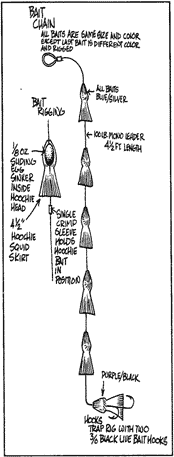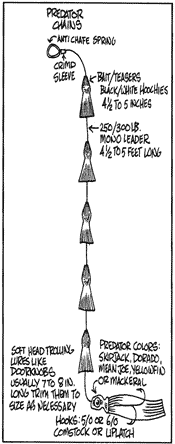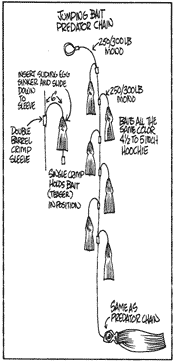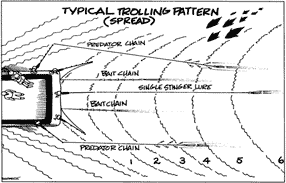
Sponsored by Pacific West Sportfishing and the Hotel Los Barriles.
Daisy chains are a powerful fish raising strategy because of the natural appearance they have when trolled at high, medium and slow speeds, depending on the types of lures and baits (teasers) selected for chain assembly.
To understand this technology, one must first accept the concept as a proven means of attracting and catching fish. Forget that chains come from the East Coast and that they've increased catch rates in Baja's Los Cabos region - particularly on the East Cape. And that's not to mention that some of the more successful six-pack charter captains are now using this technology extensively and very successfully off Southern California.
Still, there are some West Coast anglers who may have a little difficulty accepting a method or technique that may not have been pioneered here in Southern California, and with reason: We have our own style and fishing, and are proud of the results. Yet because of our success, both as anglers and passenger-boat operators, we can be a little resistant to change. Let's look at daisy chains with an open mind.
Forget about Excuses
First, don't fall into the excuse mode for not using the chains. These excuses vary from "East Coast fish are different" to "Our fish won't go for them" or "They're too complicated to rig." Nothing could be further from the truth.
Do you think the tuna, dorado and striped marlin of the world display different behavior and instincts just because they are in Australian, Baja, California, Kona or North Carolina waters?
These fish don't think, they react, and therein lies our advantage in using the daisy chain. Remember, we are superior in reasoning power and logic, and not some fish with its brain the relative size of a raisin. Learning to get fish to react is an acquired skill and, by using the chains, will result in multiple-lure strikes on the troll, and numerous jig stops. The life of every game fish predator is dependent on its ability to react to a given stimulus for the purpose of survival and this, again, works to our advantage.
As with all lures, jigs and artificial baits, their sizes, colors and swimming actions are all-important. However, there are some very subtle and scientific attributes that give chains a natural profile, which, when incorporated properly, are virtually irresistible to game fish.
A Natural Presentation

Click on the image for a larger version
This is the precept, in reference to baitfish, that governs the instinctive willingness of game fish to attack the chains. Trolling daisy chains provides the illusion of a small group of bait or squid in turbulent water (caused by the boat wake) and being attacked by larger fish (the boat's turning propellers). This illusion, without question, provides a much more natural presentation of real life in the predatory fish environment than could ever be presented by trolling only single lures.
It's a well known fact that game fish have exceptional vision and can easily and clearly spot single lures from a distance, so again, the chains provide additional provocation. Think about it. In the wild, when baitfish are attacked, they break up into smaller pods. This breakup leaves them even more vulnerable to further attack; this is exactly how nature works and is what trolled bait chains represent.
Consider, too, that game fish always attack the last fish in a school or tandem series. The predator may sense that the last fish is weak or injured and not likely to escape.
Competition among other predators is another strong force governing behavior. The size of the fish relative to competition is irrelevant; from the smallest sauries feeding on zooplankton to a 200-pound yellowfin tuna devouring small bonito or mackerel, each predator fish must react quickly and decisively, or lose that meal to another fish. The competition between game fish for the same bait - say, big tuna mixed with small dorado or skipjack - only creates a stronger sense of urgency inducing game fish to become less discriminatory eaters.
Gamefish Weaknesses
In the natural order of schooling baitfish, there are two factors which are critical to the survival of every fish in the school. Surprisingly, they are not the safety-in-numbers criterion or the ability to reproduce in sufficient numbers to perpetuate the species. No, these laws are geometry and conformity. Baitfish have the distinct characteristic and ability to geometrically maintain order within the school, and in a form or shape which provides protection and ease of feeding.
Have you ever noticed that baitfish always seem to be keeping their own space and that this space is never violated or intruded upon by other baitfish? The size of the space may vary, depending on environmental or survival conditions. This personal bait zone may become larger when baitfish are not feeding or being pursued by predators; smaller or tighter when the baitfish feel threatened. This natural zone or "personal" space is a very real phenomenon and can be used advantageously with the daisy chain technology.
A most important and meaningful law for baitfish is conformity. This law requires that all fish in a given school be of the same size and color. This also provides insurance that the safety-in-numbers law will prevail. Those baitfish that are different stand out to the predators, are targeted immediately and are consumed; nature has identified them to the predators as sick or injured, and they will also look and behave differently than the others. If it stands out, it dies, simple as that.
Chain Illusions

Click on the image for a larger version
Daisy chains are assembled in a number of ways, but two that are most popular are the bait chain and the predator chain. Bait chains are exactly that: a small group of baits, with the last one rigged with a hook. A predator chain is basically the same, except that the last lure is considerably larger in size, replicating a predator fish in pursuit.
Think about it. To a real predator game fish, the illusion is that you are now trolling a school of baitfish and they (the school) are cut off from the main group. This is a very natural presentation and is just what game fish are seeking natural setup for a free lunch. Employing this strategy, pulling four chains in your wake creates a lure spread with more fish attracting ability than five boats, each set up trolling four single lures!
Incorporating baitfish attributes, once understood, is simple and works consistently well. For example, baitfish do not swim around by themselves; their normal behavior is to swim together. This very routine and natural order must be incorporated into your chains.
Always make sure that spacing between the baits (teasers) is as natural looking as possible, but spacing between them does not have to be perfect. You do not have to rig all baits, for example, exactly six inches apart - five to seven inches is close enough. To achieve a natural profile in the chain, use rigged baits that are the same sizes and shapes, but use a different color or pattern on the last, hook-rigged bait (thus, making it appear different and vulnerable to a predator). Use the same guidelines for making predator chains, except, of course, use a larger, "predator" lure as the last in the series.
Jumping bait chains are another daisy-chain option. Jumping bait chains are assembled a bit differently; they are set up so the baits or teasers jump out of the water and skip around the surface. This action not only looks natural, but can be used with the erratically-swimmingcedarplugs. The cedar plug/vinyl teaser lure combination works very well on striped marlin, dorado and tuna; while ajumping bait chain assembled with 8-inch squids and a darker, hook-rigged squid in the tail section works very well on big blue marlin and large yellowfin tuna. For best results with jumping chains, rig them as a predator type.
Work the Corners
Make no mistake, amigos. Game fish such as striped and blue marlin, tuna, dorado and wahoo are not afraid of boats! They don't even know what they are! In fact, it's the boat's turbulence - the engine noise, vibrations, sight of the wake and the illusion of the chain from below - that gets gamefish curiosity rising. Maintain this image in your mind and you'll understand chain technology.

Click on the image for a larger version.
The most important locations for trolling chains are the port and starboard corners, and relatively close to the boat. Many anglers don't realize how many hookup opportunities they miss by not using chains in these hot locations. The corners are where fish coming up from deep water are most likely to show, and right behind the bait ball. While this applies more to tuna, which spend most of their time in deep water, many a striped and blue marlin have come from deep water to hit lures at the corner.
If you're not placing chains in the corners, tuna and marlin may approach and find nothing to keep them there.
One of the most effective spreads, especially as I've found on Baja's East Cape, uses five trolling rods (a sixth rod is kept ready, for use with a dropback bait). Each stern corner is set up with a bait chain on flat-line clips, two to three waves behind the boat. Then run the outrigger lines, with predator chains, at four to five waves behind the boat. Last, try my secret weapon, the stinger lure -a single lure, small predator type - trolled right down the middle about six waves behind the boat. (Something that worked well for me last year as a stinger was the new Fintastic jig by II Sharp lures.)
As for trolling speeds, there's a vast difference of opinion, but I've found two speed ranges that seem to consistently produce. For both striped and blue marlin, trolling about 10 knots is a good compromise between daisy chain attractability and covering a lot of water. For tuna, dorado, wahoo and yellowtail, you can slow that down a bit, to eight knots. Of course, when the weather gets bumpy, you can still get hookups at five to seven knots, while increasing angler comfort.
If you haven't yet tried daisy chains, now's the time to start. Learning new techniques and giving them a fair test of time will foster confidence in this style of fishing, and confidence will equal success.

Click on the image for a larger version.